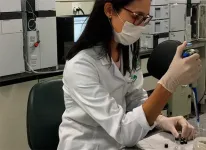(Press-News.org) Ottawa, ON, September 5, 2023 – Annual rates of emergency department visits for cannabis-involved traffic injury increased by 475 percent over 13 years, according to a new study from The Ottawa Hospital, Bruyère Research Institute, and ICES.
The study examined cannabis-involvement in emergency department (ED) visits for traffic injuries between 2010 and 2021 and looked for changes after the legalization of cannabis in October 2018 and following the commercialization of the legal market (expanded cannabis products and retail stores), which overlapped with the COVID-19 pandemic.
“Our findings highlight a concerning increase in cannabis-involvement in traffic-injury emergency visits over time, with even sharper spikes following the phases of legalization and commercialization,” says lead author and ICES post-doctoral trainee Dr. Daniel Myran, who is also a family physician and fellow at the Bruyère Research Institute and The Ottawa Hospital. “Conversely, alcohol-involvement in traffic injury ED visits did not increase over the study period, which suggests that legalization of cannabis has played an important role in rising rates.”
While documented cannabis-involvement in traffic injuries ED visits were very rare, the data raise concern about potential broader increases in cannabis-impaired driving which may have accelerated after legal market expansion.
Published in JAMA Network Open, the researchers examined medical record data of 947,604 ED visits for traffic in in Ontario, Canada. They included records from January 2010 and December 2021, but excluded ED visits from individuals who were younger than 16 (minimum legal age of driving) at the time of the ED visit.
Key findings include:
The number of cannabis-involved traffic injury ED visits increased significantly. Annual rates of visits surged by 475 percent, from 0.18 visits per 1,000 total motor vehicle collisions in 2010 to 1.01 in 2021.
Legalization of non-medical cannabis with restrictions was associated with a 94 percent increase in the rate of cannabis-involved traffic injury ED visits compared to the pre-legalization period. The subsequent phase of commercialization, which overlapped with the COVID-19 pandemic, saw an even greater increase of 223 percent in rates compared to the pre-legalization period.
Male sex (assigned at birth), living in lower-income neighborhoods, being aged 19-21, and having a prior cannabis-related ED visit were associated with higher rates of ED visits.
“The observed increase in cannabis-involved traffic injuries might reflect broader trends in cannabis-impaired driving,” says Dr. Myran. “The study highlights the need for enhanced prevention efforts, including targeted education and policy measures.”
One limitation of the study is that ED staff may have been more aware of the potential for cannabis-related traffic injuries after legalization, leading to higher levels of testing for cannabis. The researchers believe that this would not have explained all the observed increase due to the severity of traffic injuries, which would be thoroughly investigated despite policy or testing procedure changes.
The authors caution that it is too soon to understand the impact of cannabis legalization on road safety particularly because of the enormous decline in driving and mobility during the pandemic, which overlapped with much of the legalization period.
The study, “Cannabis-involvement in traffic injury emergency department visits after the legalization and subsequent commercialization of non-medical cannabis” was published in JAMA Network Open.
Author block: Myran DT, Gaudreault A, Pugliese M, Manuel D, Tanuseputro P.
ICES is an independent, non-profit research institute that uses population-based health information to produce knowledge on a broad range of healthcare issues. Our unbiased evidence provides measures of health system performance, a clearer understanding of the shifting healthcare needs of Ontarians, and a stimulus for discussion of practical solutions to optimize scarce resources. ICES knowledge is highly regarded in Canada and abroad and is widely used by government, hospitals, planners, and practitioners to make decisions about care delivery and to develop policy. For the latest ICES news, follow us on Twitter: @ICESOntario
The Bruyère Research Institute supports investigators who contribute to a better, more responsive health care system that delivers the best care to patients, residents, and families. The Institute provides solutions to improve the health and health care of aging and vulnerable Canadians. To learn more, visit http://www.bruyere.org.
The Ottawa Hospital (TOH) is one of Canada’s top learning and research hospitals where we are guided by our vision to provide the world-class and compassionate care we would all want for our loved ones. Our multi-campus hospital, affiliated with the University of Ottawa, is home to the Regional Trauma Centre and Cancer Centre, and to discoveries that are adopted globally. Backed by generous support from the community, we are focused on reshaping the future of health care to improve the health of our diverse population of patients from Eastern Ontario, Western Quebec, and Nunavut. For more information about The Ottawa Hospital, visit OttawaHospital.on.ca.
The University of Ottawa is home to over 50,000 students, faculty and staff, who live, work and study in both French and English. Our campus is a crossroads of cultures and ideas, where bold minds come together to inspire game-changing ideas. We are one of Canada’s top 10 research universities—our professors and researchers explore new approaches to today’s challenges. One of a handful of Canadian universities ranked among the top 200 in the world, we attract exceptional thinkers and welcome diverse perspectives from across the globe. www.uottawa.ca
END
Commercialization of cannabis linked to increased traffic injuries
2023-09-06
ELSE PRESS RELEASES FROM THIS DATE:
The discovery of a new kind of cell shakes up neuroscience
2023-09-06
Neuroscience is in great upheaval. The two major families of cells that make up the brain, neurons and glial cells, secretly hid a hybrid cell, halfway between these two categories. For as long as Neuroscience has existed, it has been recognized that the brain works primarily thanks to the neurons and their ability to rapidly elaborate and transmit information through their networks. To support them in this task, glial cells perform a series of structural, energetic and immune functions, as well as stabilize physiological constants. Some of these glial cells, known as astrocytes, ...
Enhanced recovery program successfully reduced opioid use after pancreatic cancer surgery
2023-09-06
By improving hospital care pathways, researchers from The University of Texas MD Anderson Cancer Center successfully reduced inpatient opioid use by 50% after pancreatic cancer surgery and cut the median opioid prescription volumes at discharge to zero. This approach, described in a study published today in JAMA Surgery, could help reduce the risk of long-term opioid dependence in patients.
In this cohort study, which involved 832 patients undergoing pancreatic resection surgery, the researchers investigated how making incremental modifications to post-surgery procedures affected the amounts of opioids used by inpatients and at the point of discharge. In less ...
Study finds increase in travelers to Massachusetts seeking abortion care post-Dobbs
2023-09-06
Analysis led by Brigham researchers showed an increase in out-of-state abortion travelers to Massachusetts from other states including Texas, Louisiana, Florida, and Georgia after Dobbs.
Use of non-profit funding by charitable organizations for abortion care more than doubled among out-of-state travelers
A rigorous analysis by researchers confirms a rise in out-of-state travelers coming to Massachusetts to seek abortion care. In a new study by investigators from Brigham and Women’s Hospital, a founding member ...
Incidence of in situ and invasive cutaneous melanomas during the pandemic
2023-09-06
About The Study: Researchers identified decreases of in situ and invasive melanoma diagnoses during 2020, which may reflect decreased skin cancer screening examinations or access to dermatologic care during the pandemic, both of which may lead to reduced melanoma diagnoses. This study adds to the current literature by highlighting that the relative increase in thick melanomas in 2020 was primarily associated with a marked decrease in thin melanomas, rather than an absolute increase in thicker melanomas.
Authors: Rebecca I. Hartman, M.D., M.P.H., of Brigham and Women’s Hospital in Boston, is the corresponding author.
To access the embargoed study: Visit ...
Cannabis-involved traffic injury emergency department visits after cannabis legalization and commercialization
2023-09-06
About The Study: This study found large increases in cannabis involvement in emergency department visits for traffic injury over time in Ontario, Canada, which may have accelerated following nonmedical cannabis commercialization. Although the frequency of visits was rare, they may reflect broader changes in cannabis-impaired driving. Greater prevention efforts, including targeted education and policy measures, in regions with legal cannabis are indicated.
Authors: Daniel T. Myran, M.D., M.P.H., of the University of Ottawa in Ottawa, Ontario, Canada, is the corresponding author.
To access the embargoed study: Visit our For The Media website at this link https://media.jamanetwork.com/
(doi:10.1001/jamanetworkopen.2023.31551)
Editor’s ...
Furthest ever detection of a galaxy’s magnetic field
2023-09-06
Using the Atacama Large Millimeter/submillimeter Array (ALMA), astronomers have detected the magnetic field of a galaxy so far away that its light has taken more than 11 billion years to reach us: we see it as it was when the Universe was just 2.5 billion years old. The result provides astronomers with vital clues about how the magnetic fields of galaxies like our own Milky Way came to be.
Lots of astronomical bodies in the Universe have magnetic fields, whether it be planets, stars or galaxies. “Many people ...
The first organic oscillator that makes catalysis swing
2023-09-06
Oscillating chemical systems are present at nearly every popular chemistry exhibition – especially the ones that display striking colour changes. But so far there are very few practical uses for these types of reactions beyond timekeeping. In nature, on the other hand, many important life processes such as cell division and circadian rhythms involve oscillations. Scientists at the University of Groningen have now developed an oscillating system that contains a catalyst, and exhibits periodic catalytic activity: this synthetic chemical oscillator can do more than just keep time. A description of this ...
Scripps Research chemists devise a method for C-H activation of alcohols
2023-09-06
LA JOLLA, CA—Scripps Research chemists have extended a powerful molecule-building method—called C-H activation—to the broad class of chemicals known as alcohols.
The synthetic chemistry feat, reported in Nature on September 6, 2023, follows the development of C-H activation techniques for the three other major classes of organic molecule—amines, acids and ketones—that are used to construct pharmaceuticals. It gives chemists a versatile new toolkit for making drugs and other valuable compounds now using the alcohol chemical class; moreover, its ...
Pitt researchers to study Alzheimer’s disease in marmosets
2023-09-06
PITTSBURGH – To reimagine existing preclinical trials for Alzheimer’s disease, University of Pittsburgh School of Medicine neuroscientists created the first non-human primate model of hereditary Alzheimer's in marmoset monkeys, outlining their approach in Alzheimer's & Dementia: Translational Research & Clinical Interventions.
Researchers are now working on characterizing and validating genetic, molecular, functional and cognitive features of aging and Alzheimer’s disease in marmosets that harbor mutations in the same gene that is linked to early-onset disease in humans. Scientists hope to accelerate the pace of the ...
Oral health deteriorates before and after bariatric surgery, study shows
2023-09-06
Oral health deteriorates in morbidly obese people on a diet in preparation for bariatric surgery and patients who have undergone the procedure, with increasing caries, gingivitis and periodontitis. This is the conclusion of a study conducted by researchers at the Federal University of São Paulo (UNIFESP) in Brazil. Articles on the study are published in the Journal of Oral Rehabilitation and Clinical Oral Investigations, stressing the importance of participation by a dentist in the assessment of bariatric patients.
The study was funded by FAPESP (projects 17/26400-6 and 16/10940-9), following 100 patients divided into two groups (dietary ...



